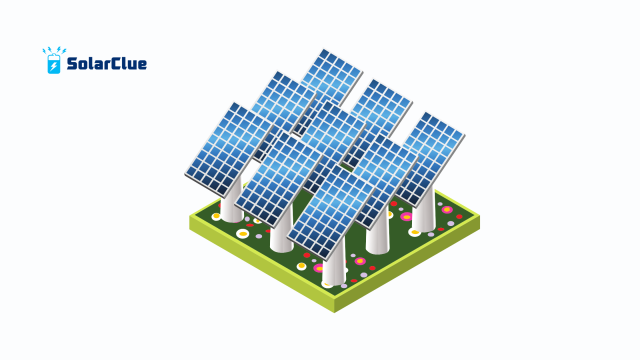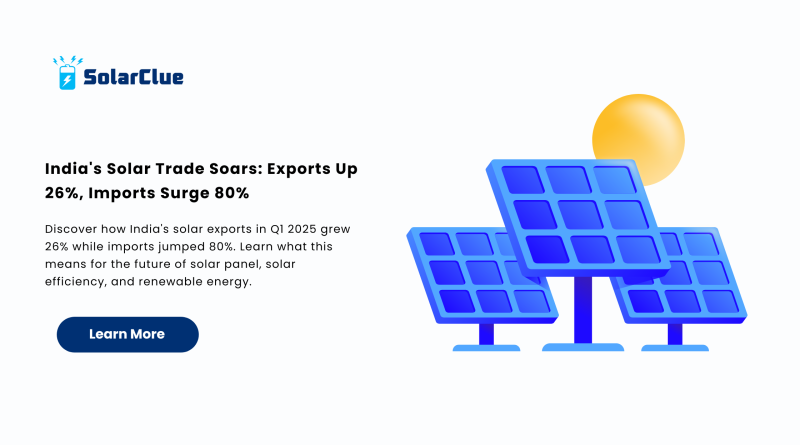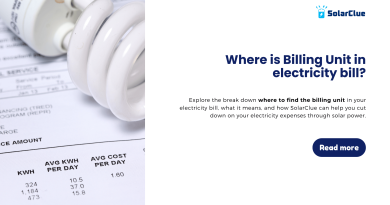India’s Solar Trade Soars: Exports Up 26%, Imports Surge 80%
India’s solar exports in Q1 2025 have experienced an impressive 26.1% quarter-over-quarter growth, while imports have surged by an even more dramatic 80.2%. These figures, reported by the Department of Commerce, reflect a changing landscape in the Indian solar industry—driven by rising global demand, domestic policy reforms, and rapid technological advancement. In this blog, we dive deep into what these numbers mean, where the market is heading, and how this impacts consumers, manufacturers, and global trade relations.
Table of Contents
- 1 The Q1 2025 Boom in India’s Solar Trade
- 2 The U.S. Leads the Demand for Indian Solar Modules
- 3 Key Importing Countries: China Still Dominates
- 4 Domestic Policy Reforms and the ALMM Impact
- 5 Domestic Manufacturing on the Rise
- 6 Top Manufacturers in the Indian Market
- 7 Shifting Balance Between Imports and Exports
- 8 Solar Demand in Residential and C&I Segments
- 9 Rural Solar Adoption Accelerates
- 10 How Solar Efficiency Is Driving the Market
- 11 Opportunities for Export Growth
- 12 The Challenge of High Import Dependence
- 13 Looking Ahead: The Future of Indian Solar
- 14 What It Means for Indian Consumers
- 15 Why This Trade Surge Matters
- 16 FAQs
The Q1 2025 Boom in India’s Solar Trade
India exported solar panels and solar cells worth $267.6 million (₹23.1 billion) in Q1 2025, compared to $212.2 million in Q4 2024. This represents a healthy 26% growth, largely fueled by rising international demand for Indian-manufactured photovoltaic modules. Although exports were down 59.9% year-over-year, the quarter-on-quarter momentum remains strong and suggests recovery and expansion.
Conversely, solar imports into India jumped to $1.3 billion (₹112.8 billion), up from $723.4 million in Q4 2024. This 80.2% surge was primarily driven by companies rushing to import modules before stricter domestic content mandates kicked in.
The U.S. Leads the Demand for Indian Solar Modules
The United States continues to be the top importer of Indian solar products, accounting for an astounding 99.5% of total exports. This indicates growing trust in India’s solar manufacturing capabilities and a strategic partnership in clean energy exchange. Indian solar energy products are highly competitive, offering a balance of performance and price that appeals to international developers.
Key Importing Countries: China Still Dominates
China remains the leading supplier of imported solar cells and modules to India, accounting for 78.1% of total imports in Q1 2025. Vietnam (9.8%) and Hong Kong (5.6%) follow behind. These imports mainly supply the commercial and industrial (C&I) sector, behind-the-meter installations, and legacy projects not bound by ALMM regulations.
Domestic Policy Reforms and the ALMM Impact
The reimposition of the Approved List of Models and Manufacturers (ALMM) significantly influenced trade dynamics in Q1. Government-funded solar projects are now required to use modules listed under the ALMM, driving increased demand for domestically manufactured modules. This policy is part of India’s larger effort to boost local industry, improve solar efficiency, and reduce reliance on imports for strategic sectors.
Domestic Manufacturing on the Rise
In 2024, India added 25.3 GW of solar panel manufacturing capacity and 11.6 GW of solar cell capacity. This is a huge leap forward and showcases India’s potential to not only fulfill domestic demand but also become a global manufacturing hub. Indian companies are now focusing on producing higher efficiency modules such as mono-PERC and bifacial panels, which are rapidly gaining popularity due to their improved performance.
Top Manufacturers in the Indian Market
Leading names like Waaree Energies, Adani Solar, and Vikram Solar continue to dominate the domestic market. International firms like Jinko Solar, Trina Solar, and LONGi are also active players. These companies are pushing the envelope in solar efficiency, offering products that cater to both budget and high-performance segments.
Shifting Balance Between Imports and Exports

The surge in imports isn’t necessarily a setback—it’s a short-term phenomenon tied to project timelines and policy shifts. In the long term, the government’s push for Make in India will likely lead to greater self-reliance. As domestic manufacturing scales, imports will become more strategic and selective, mainly focusing on specialized products not yet made in India.
Solar Demand in Residential and C&I Segments
Both residential and C&I segments are experiencing significant adoption of solar power systems. Rising electricity prices and environmental awareness are pushing homeowners and businesses toward solar energy solutions. Consumers are now seeking energy independence, and the availability of high-efficiency modules—both domestic and imported—is accelerating this trend.
Rural Solar Adoption Accelerates
In rural India, government schemes and NGO-led projects are bringing solar power to areas previously off the grid. Solar microgrids, rooftop installations, and solar-powered irrigation systems are becoming common, improving quality of life and supporting agriculture. The expansion of solar power systems in these areas plays a key role in inclusive growth and long-term sustainability.
How Solar Efficiency Is Driving the Market
One of the biggest drivers in both export and import markets is solar efficiency. Buyers today look beyond price—they want performance, reliability, and long-term savings. Higher efficiency modules reduce the number of panels required, minimize land usage, and optimize output, making them ideal for both utility-scale and rooftop installations.
Opportunities for Export Growth
As countries around the world ramp up their renewable energy goals, India has a massive opportunity to become their preferred supplier of solar panels, inverters, and related technologies. India’s solar exports in Q1 2025 are just the beginning. With the right investments and policy support, India can double or even triple its export share in the coming years.
The Challenge of High Import Dependence
However, India must address its high dependence on imports for key components like wafers and polysilicon. Without strengthening upstream manufacturing, the industry remains vulnerable to global price fluctuations and supply chain bottlenecks. Strategic investments in the entire value chain are essential to sustain growth.
Looking Ahead: The Future of Indian Solar
The outlook for the remainder of 2025 is optimistic. The second quarter is expected to see stabilization in trade numbers as ALMM regulations fully take hold. Domestic manufacturers will benefit from improved margins, while importers may shift focus to premium, high-tech products. The push for renewable energy across sectors will keep demand strong.
What It Means for Indian Consumers
For the average consumer, all this translates to more choices, better pricing, and improved product quality. Whether you’re a homeowner looking for a rooftop setup or a business investing in a large solar power system, the market is offering more competitive and efficient solutions than ever before.
Why This Trade Surge Matters
India’s solar exports in Q1 2025 highlight the country’s growing role in the global clean energy movement. It’s not just about trade—it’s about energy security, economic growth, job creation, and environmental leadership. The solar industry’s evolution reflects a larger shift toward sustainability, where India is poised to lead.
FAQs
1. Why did India’s solar imports surge in Q1 2025?
Imports increased by 80.2% as developers rushed to complete projects before stricter domestic content requirements under ALMM took full effect.
2. Who are the top importers of Indian solar modules?
The United States was the top importer, accounting for 99.5% of India’s solar exports in Q1 2025.
3. Which companies are leading India’s solar manufacturing efforts?
Top players include Waaree Energies, Adani Solar, Vikram Solar, Jinko Solar, and Trina Solar.
4. How does solar efficiency affect installation?
Higher solar efficiency means fewer panels are needed for the same output, making installations more space and cost-effective.
5. What are the long-term prospects for India’s solar exports?
India is well-positioned to become a global solar manufacturing hub, with growing exports expected over the next few years.
Explore reliable, efficient, and affordable solar solutions at www.solarclue.com and stay updated on the latest industry insights at blog.solarclue.com. Power your future with solar—because the sun never sends a bill!




